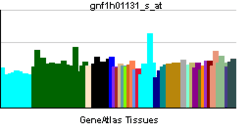Sialic acid-binding Ig-like lectin 12
Sialic acid-binding Ig-like lectin 12 is a protein that in humans is encoded by the SIGLEC12 gene.[2][3][4]
Sialic acid-binding immunoglobulin-like lectins (SIGLECs) are a family of cell surface proteins belonging to the immunoglobulin superfamily. They mediate protein-carbohydrate interactions by selectively binding to different sialic acid moieties present on glycolipids and glycoproteins. This gene encodes a member of the SIGLEC3-like subfamily of SIGLECs. Members of this subfamily are characterized by an extracellular V-set immunoglobulin-like domain followed by two C2-set immunoglobulin-like domains, and the cytoplasmic tyrosine-based motifs ITIM and SLAM-like. The encoded protein, upon tyrosine phosphorylation, has been shown to recruit the Src homology 2 domain-containing protein-tyrosine phosphatases SHP1 and SHP2. It has been suggested that the protein is involved in the negative regulation of macrophage signaling by functioning as an inhibitory receptor. This gene is located in a cluster with other SIGLEC3-like genes on 19q13.4. Alternatively spliced transcript variants encoding distinct isoforms have been described for this gene.[4]
References
- ↑ "Human PubMed Reference:".
- ↑ Foussias G, Taylor SM, Yousef GM, Tropak MB, Ordon MH, Diamandis EP (Jun 2001). "Cloning and molecular characterization of two splice variants of a new putative member of the Siglec-3-like subgroup of Siglecs". Biochem Biophys Res Commun. 284 (4): 887–99. doi:10.1006/bbrc.2001.5052. PMID 11409877.
- ↑ Yu Z, Lai CM, Maoui M, Banville D, Shen SH (Jun 2001). "Identification and characterization of S2V, a novel putative siglec that contains two V set Ig-like domains and recruits protein-tyrosine phosphatases SHPs". J Biol Chem. 276 (26): 23816–24. doi:10.1074/jbc.M102394200. PMID 11328818.
- 1 2 "Entrez Gene: SIGLEC12 sialic acid binding Ig-like lectin 12".
Further reading
- Maruyama K, Sugano S (1994). "Oligo-capping: a simple method to replace the cap structure of eukaryotic mRNAs with oligoribonucleotides.". Gene. 138 (1–2): 171–4. doi:10.1016/0378-1119(94)90802-8. PMID 8125298.
- Suzuki Y, Yoshitomo-Nakagawa K, Maruyama K, et al. (1997). "Construction and characterization of a full length-enriched and a 5'-end-enriched cDNA library". Gene. 200 (1–2): 149–56. doi:10.1016/S0378-1119(97)00411-3. PMID 9373149.
- Angata T, Varki NM, Varki A (2001). "A second uniquely human mutation affecting sialic acid biology". J. Biol. Chem. 276 (43): 40282–7. doi:10.1074/jbc.M105926200. PMID 11546777.
- Strausberg RL, Feingold EA, Grouse LH, et al. (2003). "Generation and initial analysis of more than 15,000 full-length human and mouse cDNA sequences". Proc. Natl. Acad. Sci. U.S.A. 99 (26): 16899–903. doi:10.1073/pnas.242603899. PMC 139241
 . PMID 12477932.
. PMID 12477932.
- Clark HF, Gurney AL, Abaya E, et al. (2003). "The Secreted Protein Discovery Initiative (SPDI), a Large-Scale Effort to Identify Novel Human Secreted and Transmembrane Proteins: A Bioinformatics Assessment". Genome Res. 13 (10): 2265–70. doi:10.1101/gr.1293003. PMC 403697
 . PMID 12975309.
. PMID 12975309.
- Ota T, Suzuki Y, Nishikawa T, et al. (2004). "Complete sequencing and characterization of 21,243 full-length human cDNAs". Nat. Genet. 36 (1): 40–5. doi:10.1038/ng1285. PMID 14702039.
- Gerhard DS, Wagner L, Feingold EA, et al. (2004). "The Status, Quality, and Expansion of the NIH Full-Length cDNA Project: The Mammalian Gene Collection (MGC)". Genome Res. 14 (10B): 2121–7. doi:10.1101/gr.2596504. PMC 528928
 . PMID 15489334.
. PMID 15489334.

 . PMID 12477932.
. PMID 12477932. . PMID 12975309.
. PMID 12975309. . PMID 15489334.
. PMID 15489334.